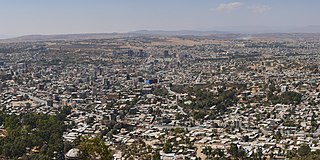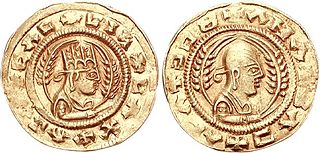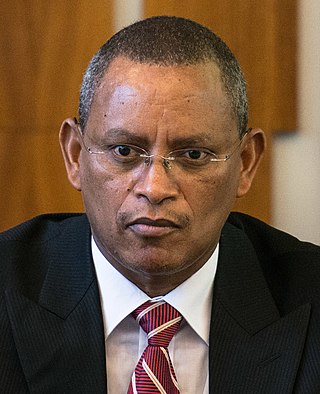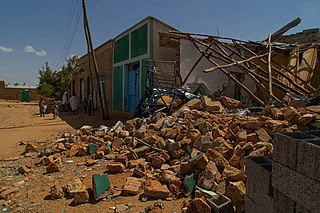
Ethiopia, officially the Federal Democratic Republic of Ethiopia, is a landlocked country located in the Horn of Africa region of East Africa. It shares borders with Eritrea to the north, Djibouti to the northeast, Somalia to the Northeast, East and Southeast, Kenya to the South, South Sudan to the West, and Sudan to the Northwest. Ethiopia covers a land area of 1,112,000 square kilometres. As of 2023, it is home to around 128 million inhabitants, making it the 13th-most populous country in the world, the 2nd-most populous in Africa after Nigeria, and the most populated landlocked country on Earth. The national capital and largest city, Addis Ababa, lies several kilometres west of the East African Rift that splits the country into the African and Somali tectonic plates.

Axum, also spelled Aksum, is a town in the Tigray Region of Ethiopia with a population of 66,900 residents. It is the site of the historic capital of the Aksumite Empire.
Yeha is a town in the Maekelay Zone of the northern Tigray Region in Ethiopia. It likely served as the capital of the pre-Aksumite kingdom of D'mt.

The Tigray, officially the Tigray National Regional State, is the northernmost regional state in Ethiopia. The Tigray Region is the homeland of the Tigrayan, Irob and Kunama people. Its capital and largest city is Mekelle. Tigray is the fifth -largest by area, the fourth-most populous, and the fifth-most densely populated of the 11 regional states.

The Church of Our Lady, Mary of Zion is an Ethiopian Orthodox Tewahedo Church which is claimed to contain the Ark of the Covenant.

Mekelle, or Mekele, is a special zone and capital of the Tigray Region of Ethiopia. Mekelle was formerly the capital of Enderta awraja in Tigray. It is located around 780 kilometres (480 mi) north of the Ethiopian capital Addis Ababa, with an elevation of 2,254 metres (7,395 ft) above sea level. Administratively, Mekelle is considered a Special Zone, which is divided into seven sub-cities. It is the economic, cultural, and political hub of northern Ethiopia.

The Tekezé or Täkkäze River, also spelled Takkaze, is a major river of Ethiopia. For part of its course it forms a section of the westernmost border of Ethiopia and Eritrea. The river is also known as the Setit as it joins the Nile tributary Atbarah River just over the border in Sudan. According to materials published by the Ethiopian Central Statistical Agency, the Tekezé River is 608 kilometers (378 mi) long. The canyon which it has created is the deepest in Africa and one of the deepest in the world, at some points having a depth of over 2000 meters.

The Zagwe dynasty was a medieval Agaw monarchy that ruled the northern parts of Ethiopia and Eritrea. The Agaw are a Cushitic ethnic group native to the northern highlands of Ethiopia and neighboring Eritrea. Centered at Roha, it ruled large parts of the territory from approximately 1137 to 1270 AD, when the last Zagwe King Za-Ilmaknun was killed in battle by the forces of the Amhara King Yekuno Amlak. The Zagwe are most famous for their king Gebre Meskel Lalibela, who is credited with having ordered the construction of the rock-hewn monolithic churches of Lalibela.

Tigray Province, also known as Tigre, was a historical province of northern Ethiopia that overlayed the present day Afar and Tigray regions. Akele Guzai borders with the Tigray province. It encompassed most of the territories of Tigrinya-speakers in Ethiopia. Tigray was separated from the northern Tigrinya speaking territories by the Mareb River, now serving as the state border to Eritrea, bordering Amhara region in the south.

Religion in Eritrea consists of a number of faiths. The two major religions in Eritrea are Christianity and Islam. However, the number of adherents of each faith is subject to debate. Estimates of the Christian share of the population range from 47% and 63%, while estimates of the Muslim share of the population range from 37% to 52%.

The Kingdom of Aksum also known as the Kingdom of Axum, or the Aksumite Empire, was a kingdom in East Africa and South Arabia from classical antiquity to the Middle Ages. Based in what is now northern Ethiopia and Eritrea, and spanning present-day Djibouti and Sudan, it extended at its height into much of South Arabia during the reign of Kaleb of Axum. Aksumite under Kaleb invaded Southern Arabia and Yemen from 520 and controlled it until 525 when Sumyafa Ashwa was deposed by Abraha.
Angot was a historical province in northern Ethiopia. It was bordered on the west by Bugna and the Afar lowlands to the east and southeast, Ambassel to the southwest and Lasta to the north.

Debretsion Gebremichael is an Ethiopian politician serving as the chairman of Tigray People's Liberation Front (TPLF). He was previously the president of the Tigray Region. His position as titular head of the Tigray Region was disputed by the federal government of Ethiopia who in November 2020 appointed Mulu Nega as the chief executive of the Transitional Government of Tigray, succeeded by Abraham Belay. From July 2021 to March 2023, Debretsion again led the Tigray Region, while Abraham Belay left the transitional government to become Ethiopia's minister of Defence.
Events of 2020 in Ethiopia.
The Ethiopian Human Rights Commission (EHRC) is a national human rights institution (NHRI) established by the Ethiopian government. The EHRC is charged with promoting human rights and investigating human rights abuses in Ethiopia. The EHRC states organizational independence as one of its values. In October 2021, the EHRC's rating by the Global Alliance of National Human Rights Institutions for operation in accordance with the UN Paris Principles was upgraded from grade B to grade A.

The Axum massacre was a massacre of about 100–800 civilians that took place in Axum during the Tigray War. The main part of the massacre occurred on the afternoon and evening of 28 November 2020, continuing on 29 November, with smaller numbers of extrajudicial killings taking place earlier, starting from 19 November and during the weeks following the 28–29 November weekend. The massacre was attributed to the Eritrean Defence Forces (EDF) by Amnesty International, Associated Press, the Ethiopian Human Rights Commission (EHRC), Human Rights Watch (HRW) and Adigrat University lecturer Getu Mak.

Sexual violence in the Tigray War included, according to the United Nations Special Representative on Sexual Violence in Conflict, Pramila Patten, people forced to rape family members, "sex in exchange for basic commodities", and "increases in the demand for emergency contraception and testing for sexually transmitted infections".

Events in Hawzen in the Tigray War included five mass extrajudicial killings that took place in Hawzen in the Tigray Region of Ethiopia during the Tigray War in November and December 2020 and January and February 2021, looting and destruction Hawzen Primary Hospital by the Eritrean Defence Force (EDF), and the establishment of a rape camp in the hospital by the Ethiopian National Defense Forces (ENDF).
This Timeline of the Tigray War is part of a chronology of the military engagements of the Tigray War, a civil war that began in the Tigray Region of Ethiopia in early November 2020.

The events of the Tigray War have sparked numerous reactions and protests worldwide.














